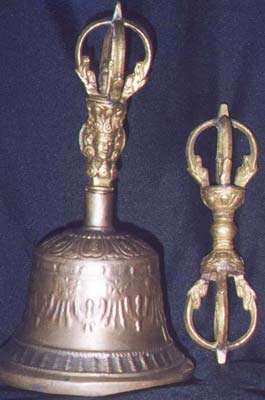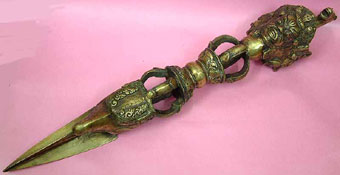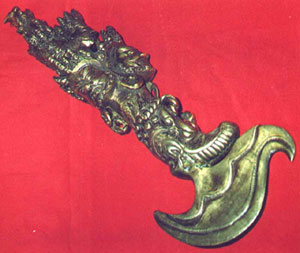.:. home .:. essays & notes .:. guestbook .:.
essays & notes
Similarities between Eastern & Western ritual implements

This article will examine the similarities between ritual implements used in the East, specifically in the Tibetan Buddhist tradition, and those used in the West, specifically in the tradition of ceremonial magick, passed down mainly through the Hermetic Order of the Golden Dawn, but espoused by many like Aleister Crowley, Dion Fortune, and Israel Regardie.
Quotations are taken from the article, "Ritual Implements in Tibetan Buddhism: A Symbolic Appraisal"
Wand & Vajra/Dhorje
The Vajra, or Dhorje in some traditions, is pictured at the top of this article. "The Vajra is the quintessential symbol of Vajrayana Buddhism, which derives its name from the vajra itself. The Sanskrit term vajra means 'the hard or mighty one', and its Tibetan equivalent dorje means an indestructible hardness and brilliance like the diamond, which cannot be cut or broken. The vajra essentially symbolizes the impenetrable, immovable, immutable, indivisible, and indestructible state of enlightenment or Buddhahood."
These qualities of hardness represent the male quality of Will, as symbolized in the Wand from the Western esoteric tradition below.

"When used in ritual, the vajra is paired with the bell. It represents the masculine principle and is held in the right hand, the bell, held in the left hand, represents the female principle. More on this follows."
Just as the Wand is the male complementing the female Cup in the Western tradition, the male vajra complements the female bell. These two symbols are united in the person holding them, also in the Hindu symbol of the Lingam-Yoni, whic his discussed below.
Cup & Bell

The cup is similar in shape to the bell (although upside-down) and they both represent the feminine principle - both have a rounded shape to them. "...in ritual the bell is paired with the vajra. The vajra represents the compassion of the Buddha, the masculine principle; and the bell represents wisdom, the female principle. To achieve enlightenment, those two principles must be combined. The bell is visualized as the Buddha's body, the vajra is visualized as his mind, and the sound of the bell is visualized as Buddha's speech in teaching of the dharma." Wisdom is, on the Tree of Life, attributed to Chokmah, but Understanding and even 'Intelligence' is attributed to Binah. Exactly what is meant by 'wisdom' is not specified here.
Dagger & Phurpa


Both the Western dagger of Air and the Easter dagger, the phurpa, are used to banish or destroy obstacles and malignant forces."A phurpa, sometimes called a "magic dagger", is a tantric ritual object used to conquer evil spirits and to destroy obstacles."
"The triple blade of the phurpa symbolizes the overcoming or cutting through of the three root poisons of ignorance, desire, and hatred, and also represents control over the three times of past, present and future. The triangular shape represents the element of fire and symbolizes wrathful activity. The tenacious grip of the makara-head at the top of the blade represents its ferocious activity." The dagger of the Western tradition was alternately attributed to Fire and the Will; the wepaons have similar purposes and are interchangeable in some respects. Air reflects certain qualities of Fire as well.
"When using the phurpa, the practitioner first meditates, then recites the sadhana of the phurpa, and then invites the deity to enter the phurpa. As he does so, the practitioner visualizes that he is frightening and conquering the evil spirits by placing the evil under the point of the phurpa. Or sometimes the practitioner visualizes throwing the phurpa in order to impale and subdue the spirits. The success will depend on the practitioner's spirituality, concentration, motivation, and his karmic connections with the deity of the phurpa and the evil spirits." The use of visualization is very prevalent in the Western tradition. Here it is being used in the Eastern Tibetan Buddhist tradition to banish unwanted influences, just like in the Banishing Ritual of the Pentagram in the Western tradition.
Pentacle & skull

The pentacle represents the element of Earth which is the receptacle of all three other elements. The skull is similarly a receptacle, but it differs in that the skull is paired with the curved blade, described below. The Sword of the Western tradition does not have as direct a relationship to the pentacle as the use of the skull with the blade.
Sword (Mars) & Curved blade


In the Western tradition, the Sword is a manifestation of Geburah & Mars and is generally used as a warning against evoked spirits. It's purpose is essentially destruction which is similar to the Curved blade used in Tibetan Buddhism."The chopper is one of the most prominent weapons used by Buddhism's angry deities, both male and female. Continuously brandished by them or simply carried in their hands, its purpose is to chop up disbelievers." Unlike the Sword and the Pentacle, the Curved blade and the Skull are considered complements in the Tibetan Buddhist tradition.